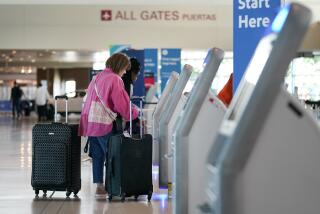Let’s Not--the Problems Lie Elsewhere
- Share via
There are lots of problems with the U.S. airline system, but deregulation isn’t one of them. Few economic and social experiments ever succeed completely. Many are utter failures. But airline deregulation has delivered most of what it promised when enacted in 1978. It has held down fares, increased competition and raised the industry’s efficiency. Despite claims to the contrary, airline safety has not suffered. And, with some exceptions, service to small cities and towns has improved.
The sudden crescendo of criticism is guilt by association. The industry seems in disarray. Frontier Airlines has gone bankrupt. People Express’ condition is precarious. Eastern Airlines is laying off 1,500 workers. The air collision over Cerritos suggests dangerous airways. Critics of deregulation warn that the industry soon will be controlled by a few huge airlines and that safety standards are falling.
Most of this criticism is irrelevant or false. Air safety remains regulated by the Federal Aviation Administration. Deregulation merely ended government control of fares and routes. No one ever said that it would be a calm process. There has been a tidal wave of new competition. Efficient carriers survive; others don’t.
Judging the public gains from this turmoil isn’t simple, because we can’t know what would have happened under continued regulation. But a study by economists Steven Morrison and Clifford Winston for the Brookings Institution simulated regulation’s effects and found huge benefits from deregulation. Other evidence supports that conclusion. Consider:
- Fares: On average, they’re now lower than in 1980. Morrison and Winston estimate that fares are about 20% to 30% below what they would be under regulation. To attract travelers, airlines devised new (often confusing) discount fares. About 90% of traffic receives discount fares, up from 57% in 1980.
- Efficiency: The industry is clearly more productive. After deregulation, the percentage of occupied seats jumped about 10% and miles traveled 32%.
- Service: Despite fears that airlines would cut unprofitable service to small communities, most smaller cities and towns experienced a 20% to 30% increase in flight frequency. Airlines shifted to smaller, more economical planes for less-traveled routes. Between 1978 and 1983 about 100 smaller communities did lose service, but under regulation 137 communities had lost service in the previous decade.
- Safety: The safety record of major U.S. scheduled airlines hasn’t changed since deregulation. The record of commuter carriers has improved. Travel on U.S. airlines remains among the safest form of transportation; between 1975 and 1985, deaths resulting from crashes totaled fewer than 3,000.
Mostly, deregulation has demonstrated competition’s virtues. Under regulation, airlines had protected routes and few pressures to cut costs, and costs could be passed along in higher fares. Facing new competitors, airlines have had to be more efficient by making better use of aircraft and devising fares to fill more seats. The dark side has been rampant labor strife as older carriers seek to bring high salaries closer to levels of new airlines.
The system is not trouble-free. Congestion is increasing. More airports may be reaching capacity. And the rise in near-collisions, especially involving private planes, suggests a need for tighter traffic controls. But these are not deregulation’s problems, and fears that safety would suffer from competitive pressures have yet to be borne out--probably because an airline cannot long survive without a reputation for safety.
Will oligopoly eventually undo competition’s gains? To keep control of more passengers, airlines are merging. In some cities, competition is decreasing. Fares may rise. But many experts believe, with good reason, that an oppressive oligopoly is unlikely. One restraint is the airlines’ need to fill seats. If fares are too high, many vacationers won’t fly. Airlines also face the constant threat that other carriers will invade their routes.
Competition is strengthened by the way the industry is organized. Deregulation caused airlines to adopt “hub-and-spoke” systems: Carriers feed traffic into “hub” cities, where passengers change for connecting flights. The result is intense competition for passengers at non-hub cities.
No air system as busy as ours will ever be perfect. There were safety problems, congestion, lost baggage and overbookings under regulation. It’s an open question whether government should spend more on safety and airport expansion. But these issues do not diminish deregulation’s success. If critics’ fears about oligopoly are realized, air travelers will lose. But, ironically, that would simply be a return to the cartel that regulation blessed and legalized.
More to Read
Inside the business of entertainment
The Wide Shot brings you news, analysis and insights on everything from streaming wars to production — and what it all means for the future.
You may occasionally receive promotional content from the Los Angeles Times.










